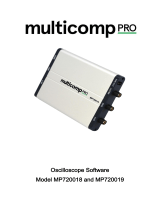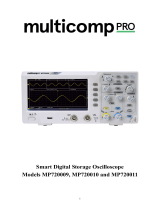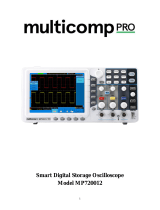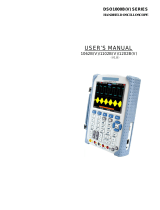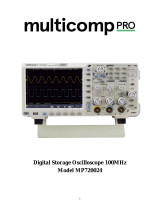OWON HDS-N Series Handheld DSO & DMM Contents
6.13 Using Persistence to Display Waveforms············································································22
6.14 Using Peak Detection to Display Glitches ···········································································23
6.15 Selecting AC-coupling···········································································································24
6.16 Reversing the Polarity of the Displayed Waveform ···························································25
6.17 Using Waveform Mathematics Functions···········································································26
6.18 Use USB mass storage device to save waveform data ························································27
7. USING THE MULTIMETER······························································ 28
7.1 About this Chapter··················································································································28
7.2 Making Meter Connections····································································································28
7.3 Multimeter Operation Window ·····························································································28
7.4 Making Multimeter Measurements ·······················································································29
7.4.1 Measuring Resistance Values·····················································································29
7.4.2 Measuring Diode··········································································································30
7.4.3 On-off Test·····················································································································31
7.4.4 Measuring Capacitance·······························································································31
7.4.5 Measuring DC Voltage·································································································32
7.4.6 Measuring AC Voltage·································································································33
7.4.7 Measuring DC Current·································································································34
7.4.8 Measuring AC Current·································································································35
7.5 Freezing the Readings·············································································································36
7.6 Taking a Relative Measurement·····························································································37
7.7 Selecting Automatic/ManualRange Adjustment···································································38
8. ADVANCED FUNCTION OF OSCILLOSCOPE·························· 39
8.1 About this Chapter··················································································································39
8.2 Setting the Vertical CH1 and CH2·························································································39
8.2.1 Setting the Channel Coupling·····················································································40
8.2.2 Open and Close Settings on Channel ·······································································41
8.2.3 Setting the probe attenuation······················································································41
8.2.4 Setting of Inverted Waveform ·····················································································42
8.3 Make the Math Function Menu Setting ················································································42
8.4 Setting the Trigger System······································································································43
8.5 Triggering Control ··················································································································44
8.5.1 Edge Trigger·················································································································44
8.5.2 Video Trigger·················································································································45
8.5.3 Alternate trigger··············································································································47
8.6 Selecting the acquisition mode ·······························································································49
8.7 Display Setting·························································································································50
8.7.1 Display Style ·················································································································50
8.7.2 Persistence···················································································································51
8.7.3 XY Mode························································································································51
8.7.4 Cymometer····················································································································52
5




















